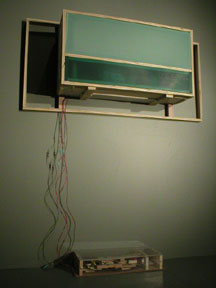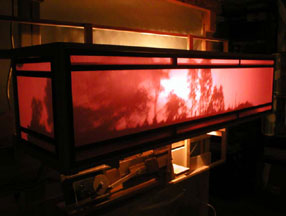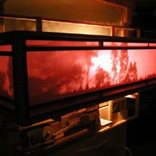When Terrie received a joint invitation from the governmental arts agencies of Norway, Finland, Sweden and Denmark to make a research trip, I quickly cashed in my frequent flier account to join her. What follows is our point-counterpoint response to what we saw in more than 80 studio visits and in numerous gallery and museum exhibitions spread over two weeks.
Stockholm, Sweden (June 5–8)
T: Stockholm is a big city scattered over several islands. We arrived on Sunday, and because Chris was busy poking his nose into restaurants, we got lost. We toured some of the less inspiring parts of town before finally arriving at the National Gallery 20 minutes before closing time. We ran through the galleries, ogling the fabulous collection, before being chased out by gallery attendants ringing large bells as if they were herders rounding up cattle.
C: Our Stockholm visit was hosted by the International Artists' Studio Program in Sweden (IASPIS). Their offices are housed in an old art school building that now hosts residency studios for Swedish artists and an archive for visiting curators. Our first visit, with Andreas Mangione and Karl Larsson, established a dominant Stockholm theme: image- and text-based conceptualism.
T: We subwayed to the suburban Marabouparken annex to see the survey of concrete poet, video artist and interior designer Karl Holmquist and to meet Johan Börjessen, the ambitious director of this new Kunsthalle. The annex will close next March and expand into the nearby Marabouparken Park. Börjessen, who was previously an education curator at the Moderna Museet, has put together a consortium of private and public funds to support his institution — an unusual Scandinavian approach. After more studio visits at IASPIS, we walked across town to Mia Sundberg Galleri to meet Anneè Olofsson. I've long been a fan of her work, so it was a pleasure to talk with her and view her challenging video narratives, which explore mutual dependencies by juxtaposing the artist with her mother or father.
C: Stockholm boasts 13 kunsthalles, but we were so busy seeing artists, we were able to see only two museums.
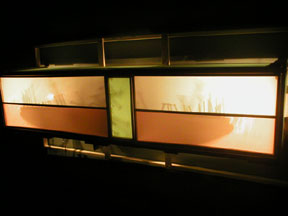
Detail of Karl Holmquist's mixed media installation... GÄVÄNTASTANNA at Marabouparken annex, Stockholm...
T: Tuesday we trekked via subway to meet Miriam Bäckström. I have followed Miriam's work for a long time, and we spent two hours discussing her new projects, and the fundamental differences between her photography and the ambitious film projects she is now embarking on. We departed in a rush to make our date with the collaborative team of Katja Aglert and Janna Homstedt, whose artistic practice centers on the 'discourse-based' website Squid. Andreas Gedin then met us at his office/studio. He was thoroughly jet-lagged, just back from a project in South Africa that involved planting flowers that will spell out phrases when they bloom. His poetic activism is indebted as much to Robert Smithson as to Joseph Beuys.
C: The next morning we met Feliz Gmelin at IASPIS to watch his videos. He has contextualized his filmmaker father's 1960s footage and other appropriated historical films with his own voice — a compelling way of addressing how time changes political beliefs. Around the corner at Galleri Magnus Karlsson, we appreciated Niklas Eneblom's crystalline landscape paintings, Roger Andersson's exquisitely refined goth watercolors and prints, and Lars Arrhenius's entertaining animations of emoticon-like people going through their daily routines.
T: When the sun begins to shine, the Scandinavian national holidays break out, so we were lucky to find my friend Lars Nittve in town. Lars took over the directorship of the Moderna Museet in a rebuilding period that coincided with the discovery of major mold problems within the museum. We exchanged mold remediation stories (mine courtesy of Houston's tropical storm Allison), and he recounted how he worked to regain the Museet's status by taking the museum's programming on the road while the building was being repaired. He also spoke of possible expansion plans for a new museum branch in Malmö, and he walked us through the in-progress installation of the huge Paul McCarthy retrospective that the Museet is originating (it travels to several other European venues — but unfortunately none in US).
C: We toured the permanent collection, trying to reconcile the angularities of Rafael Moneo's 1970s architecture with his 2000 design for the MFAH's Beck Building. Our afternoon was spent gallery hopping: Galleri Alp (Kristoffer Zetterstrand paintings), Mia Sundberg again (photographs and sculpture by Anders Krisár) and Roger Björkholmen (sculptor Hans Isaksson, who showed in Houston at Diverseworks in 2000).
T: Thursday started at IASPIS with Tova Mozard's videos. She has spent a lot time in Los Angeles, assisting James Welling and Sharon Lockhart as part of an internship/residency. Most of her videos take a documentary format: she finds eccentric characters, befriends them and then puts them in front of the camera. The best featured a well-known Swedish actor interweaving stagecraft and life.
T: To balance so much contemporaneity, we revisited the National Museum, salivating before a wall of Rembrandts, two enormous Goya works, an entire gallery of to-die-for Italian Renaissance paintings and a series of scintillating pre- through post-impressionist works — not to mention the Swedish painters and a gorgeous if weirdly installed craft collection. Having digested such convincing proof of Sweden's historical greatness, we headed for Copenhagen.
Copenhagen, Denmark (June 9–11)
T: After meeting our hosts at the Danish Arts Council offices, we set out for the first of several visits to former warehouses or factories now given over to art. After an inundation with media art at our first three stops, it was refreshing to see a lot of painting, beginning with Lise Blomberg Andersen at the Fabrikken for Kunst og Design, another city-originated, privately run studio and gallery complex. Andersen juxtaposes humans and animals in leafy outdoor settings; proving again that there are only six degrees of separation, she showed us her email correspondence with L. C. Armstrong (featured in the Blaffer's Populence ) about the rewards and tribulations of art and motherhood.
C: Studio visits are often interesting for whom the artists recommend. Lise's recommendation was Peter Calleson, a sculptor who works entirely in cut paper, making intricate philosophical enquiries using nothing more than an X-acto knife. We also saw photographer Astrid Kruse Jensen, who is working on hyperreal , a long-exposure nighttime series made at Icelandic hot springs and outdoor pools.
T: A long walk through the Islands Brygge district brought us to a former supermarket warehouse. Dating back nearly 100 years, it has been divvied up into galleries, film and audio production spaces, and artist studios. Nils Sterk, with whom I worked during Blaffer's Mads Gamdrup show, has his gallery here. We took in the gallery's current show by LA-based German painter Thaddeus Strode and sampled works by other artists. In the same complex, we visited Julie Nord's studio to see her large, intricate, ink-on-paper fantasy narratives.
C: Around the corner, Galleri Nicolai Wallner was showing Peter Land and David Shrigley. Land is best known for his clunky, awkwardly intimate videos (dancing naked, falling down stairs). His moderately sized watercolors on view depicted the hapless, slightly (and sometimes hugely) deformed children who are universal outcasts and with whom Land obviously feels a substantial empathy. Exquisite technique that deals with disturbing subject matter would also describe Scottish artist Shrigley's etchings and woodcuts. Black humor is this guy's specialty: his standout work was the bleakly hilarious animation Who I am and what I want.
T: Copenhagen boasts more galleries than the other cities we visited, perhaps because of the Danish government's heavy support for art commerce and the city's booming real estate market. A short walk brought us to Galleri Kristina Wilson, which represents a number of painters including John Körner. His paintings are colorful, childlike and expressionist. I think he takes advantage of a productive form of attention deficit syndrome.
C: We attended several openings that night. One was Usynlig Labyrint by Jeppe Hein at the Statens Museum for Kunst. The best part of this event was walking through the King's Garden Park to get there. It was a beautiful warm evening, and the park was full of people playing croquet, attending formal picnics or sunning as they munched on takeaway pizza. Hein's installation was an empty room; people wore headsets that emitted a vibration whenever they bumped into a 'wall.' I tried one, which made me feel as if I were in a bad Jacques Tati parody. We trekked through the park again to reach Charlottenborg Exhibition Hall's fantom . Organized by artists Søren Andreasen and Jesper Rasmussen, it featured 17 artists from Scandinavia and Europe in all media — a messy, wildly uneven conglomeration featuring lots of social agitprop.
T: We met up with our pal Mads Gamdrup the next morning. His new studio is located on the top floor of a recently converted factory complex in the suburban Valbyhallen District, where artists and galleries are relocating to escape the city's escalating rents. Anyone who remembers Gamdrup's monumental landscape images in the Blaffer's Renunciation would be shocked by his new work: boldly colorful, very big and nearly abstract birds and insects that are as painterly as photographs can be.
C: One of the galleries that has moved to this complex is Gallery Mogadishni. Here we met Benny Dröscher, who showed us his drawings, paintings, sculptural installations and photographs. I liked the sculptural approach he took to his repeated lexicon of mystical naturalism.
T: We rushed to catch our train back over the border to Sweden's Malmö Konsthalle, arriving late and ravenously hungry. The café looked closed, but our pathetic looks aroused the counter person, who generously fed us outside on the terrace. Fortified, we spent a long time trying to ascertain what Danish artist Simone Aaberg Kern intended with her Open Sky.
C: Kern juxtaposed painted portrait homages to WWII female pilots with historical combat footage that she interspersed with her recent interviews of the surviving women pilots. She traced her own air journey from Copenhagen across Europe to Afghanistan in red thread on two large maps displayed in different areas of the galleries, hung her Piper Cub airplane from the Konsthalle's ceiling and played highly edited videos of herself flying unaided like a superhero.
T: Malmö Konsthall's reputation for innovation is longstanding, and I was glad just to see its welcoming, wide-open, naturally lit spaces.
C: We ended our day back in Copenhagen with Anders W. Ø. Larsen, a young painter who met us in the leafy courtyard of the Charlottenberg to show us the catalogue for his just-closed show. We saw the real thing the next day at Gallery Tom Christofferson — oozing paint fields generating provocative, anxiety-filled landscapes populated by small collage figures.
T: Lawrence Weschler's 1982 New Yorker article about the Louisiana Museum was a pivotal influence on my curatorial practice, and we saved our visit to that museum for our last day. A 20-minute train ride took us to Humlebek, where we toured the permanent collection galleries, reveling as much in the museum's 'inside/outside' architecture as in the terrifically sited installation of 13 Alberto Giacometti sculptures. In conception and execution, the only American museum that approaches Denmark's Louisiana is The Menil Collection. We spent considerable time in Sip My Ocean, a show of video works drawn from the collection. The 18 artists ranged from Nam June Paik to Peter Land and Pipilotti Rist to Bill Viola, whose affecting video The Raft gives new meaning to the words 'deluge' and 'production values.' It was also great to view again The Atlantic, a Sam Taylor Wood video we first saw in Venice in 1997. This work was a key inspiration for the Blaffer exhibition I'm working on now, Damaged Romanticism.
C: We walked the grounds to explore founder Knud Jensen's progressive ideals about outdoor sculpture. The views are really impressive — rolling berms overlooking the sea encapsulate intelligently placed works by Richard Serra, Alexander Calder, Joan Miro and Henry Moore.
T: The train took us back to town for our final studio visit. We had seen Jesper Just's work at Ars 06, so he showed us earlier works and then previewed a longer work in progress that will premiere at Perry Rubenstein in New York this fall. It features, among other things, a Finnish men's choir weirdly intonating popular songs like "I've Got You Under My Skin" over Just's imagery exploring love, loss and the loneliness of life.
C: To finish our trip, we walked up the ramped eight-story observatory tower to the spot where Tyco Brahe made his astronomical discoveries, gaining a panoramic view of the eccentric historical spires that dominate Copenhagen's low-slung skyline. Then it was back to the hotel to pack and prepare for reentry into our own, steamier climes.
T: I was really surprised by how video and photography dominated what we saw, but I came away from this trip with a clearer understanding of the pervasive romanticism, tinged by harsh reality, that permeates the art of this region. I want to make this trip in winter to see firsthand the psychological darkness that pervades so much of the art.
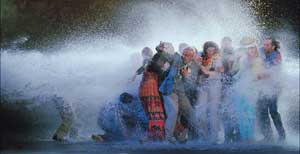
Bill Viola...The Raft...May 2004...Video/sound installation...Photo:Kira Perov...Courtesy James Cohan Gallery, New York
Tired of hot summers? Love the snow? Want to eat some herring? Denmark, Finland, and Norway offer a variety of international artist-in-residence programs. Check here for a partial listing.
Some of the exhibitions mentioned in this article remain on view; several will travel to other venues in Europe and the US:
SWEDEN
Moderna Museet, Stockholm
Paul McCarthy: Head Shop/Shop Head, through September 3.
Travels to the ARoS Aarhus Kunstmuseum, Arhus, Denmark (February 3 – May 6, 2007), and the S.M.A.K., Stedelijk Museum voor Actuele Kunst, Ghent, Belgium (October 12 – February 17, 2008).
The Clouds Between Us — and other works from the Moderna Museet Collection, through September 24.
Carl Johan De Geer: CJ's Photo Booth, through December.
Malmö Konsthall, Malmö
http://www.konsthall.malmo.se/
Simone Aaberg Kærn: Open Sky, through August 20.
DENMARK
Louisiana Museum of Modern Art, Humlebæk
SIP MY OCEAN: International video in the Louisiana Collection, through August 20.
Janet Cardiff & George Bures Miller, through September 17.
Poul Kjærholm: Furniture Architect, through October 6.
Statens Museum for Kunst, Copenhagen
http://www.smk.dk/
Jeppe Hein: Invisible Maze, through August 27.
Images courtesy Christopher French.
Christopher French is an artist and writer living in Houston. Terrie Sultan is the Executive Director of The Blaffer Gallery.


